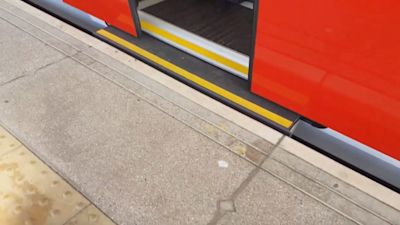What is level boarding and why would it make a difference to train travel?

Tap to find out more about level boarding, the campaign for it and hear what the rail industry says
Are disabled rail passengers being left behind by a lack of level boarding?Train operators insist they are doing everything they can to ensure people who need assistance to board trains receive it... campaigners think the industry needs to make more of an effort to create gap-free train travel.Outside of London, level boarding (where the train meets the platform) is a rarity in the Thames Valley, South and South East.It means passengers such as James Welling, who travels from Crawley, must rely on a station assistant to place a ramp between the train and platform.
Travellers in wheelchairs are advised to call ahead and James - who is part of the Campaign for Level Boarding - says this not only impacts independence but it also makes him feel a sense of train shame. Particularly if he feels he’s delaying a service…"If you feel like you’re delaying a train, especially like a high frequency network like Thameslink, you’ve got trains backing up behind you and you feel really, really bad inside you’re delaying things.Dr Jon Rey-Hastie travels from Reading and created the campaign after hearing of other rail users going through similar problems when travelling.
Dr Jon Rey-Hastie boarding at a Thameslink train in central London
He says the majority of his journeys are without problem, but the bad experiences stick with him,"I’ve had some really horrible experiences over the time. Everything from being unable to board the train because there’s no staff to help and being left out In the cold, having a train leave the station separating me from my care assistance, being forced to get off my train early before I can get to my home station because there’s nobody to get me off."
So isn't level boarding be the way forward?
The rail industry says introducing level boarding is difficult partly because several types of train use one track, like on the Brighton mainline where Southern and Thameslink both run.It means increasing the height of a platform to fit one train wouldn’t work for another, according to the sector.Train operators are finding ways to level out train travel showing that level boarding can be done.
Greater Anglia has introduced a new fleet of trains which have a retractable step.
Meanwhile at five Thameslink stations between London Bridge and St Pancras International humps have been introduced which allow for a ramp free journey.Thameslink's customer services director Jenny Saunders tells me it's only possible, because the platforms only serve one particular type of train,"It sadly won’t work at all stations across the rail network that’s because of the complexity around the different trains, with the different door heights and calling patterns they have.
"We’re really pleased we have them at these five stations we’ve had fantastic feedback and it’s transformed their journeys.""We’re here to meet the needs of all of our customers and we’re doing everything we can at Thameslink to support disabled customers so they can travel with confidence."The Campaign for Level Boarding argues progress has been slow for decades and that decisions to upgrade stations and introduce new rolling stock have not taken level boarding into account.They want to see platforms standardised to one height and new rolling stock to be built with low floors.
South Western Railway will put its new fleet into passenger service this year, Great Western’s had new trains too, there’s been HS1 through places like Margate and Ashford in Kent and stations such as Rochester and Reading have undergone huge redevelopment.Millions of pounds spent, but no level boarding.Dr Jon Rey-Hastie says, “It isn’t a quick fix and we accept that. What we want to see is that we are currently making decisions to introduce level boarding in twenty thirty years time."The problem is we’re not making those decisions, we’re making decisions which continue to perpetuate the inaccessible system."
Dominic Lund-Conlon, from the Rail Delivery Group which represents train operators, admits the industry has not always got it right but it’s always improving accessibility. "We know we don’t always get it right and we want to continually improve which is why we will work with our customers, why we will listen to their experiences."It’s important to remember that level boarding is not a one-size fits all, it’s part of a much wider piece of work we need to do that includes things like lifts and ramps, but also good information, we need to be clearer about fares and to enable customers to know what to expect when travelling."New infrastructure and trains come at a cost, but for the increased independence and less reliance on staff, campaigners say it's worth it.